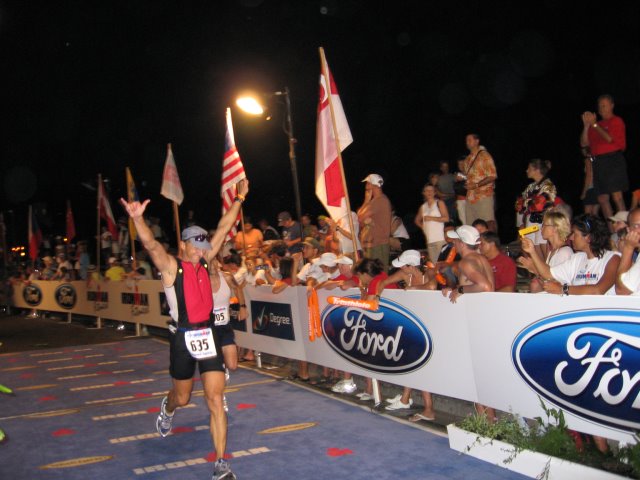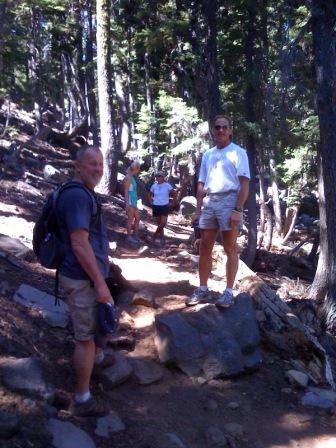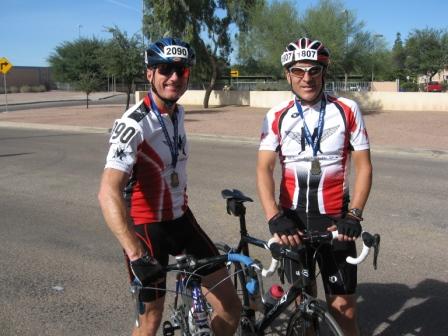Jeffrey A. Jensen - 3/12/08 - Dr. Ure
I am a 49 year old adult male that was suffering from Osteoarthritis in my left hip. I had subluxed my hip in an accident in 1995 and had experienced sporadic hip pain since then. I always lead an active lifestyle but did not compete athletically until later in life.
When I turned 40 I decided to attempt my first marathon during my mid-life crisis. I now consider myself an athlete and have competed in 15 marathon/Ultra running races, 5 full Ironman races including Ironman Hawaii in Kona.  I also enjoy backcountry snow skiing, off-road motorcycle riding, big game hunting and maintaining a very active lifestyle. In July of 2007 while on a run, the hip pain increased to the point that it was unbearable and I was forced to quit and walk home. I was able to continue to bike and swim without serious discomfort but running was out. I experimented with a cortisone shot in my hip in October of 2007 and received considerable relief. This shot had me feeling like I was a kid again and I was almost tempted to resume running. Alas it was short lived and by the first of the year, activities including downhill skiing were pretty painful. I was unable to sleep through the night and was waking numerous times in considerable pain.
I also enjoy backcountry snow skiing, off-road motorcycle riding, big game hunting and maintaining a very active lifestyle. In July of 2007 while on a run, the hip pain increased to the point that it was unbearable and I was forced to quit and walk home. I was able to continue to bike and swim without serious discomfort but running was out. I experimented with a cortisone shot in my hip in October of 2007 and received considerable relief. This shot had me feeling like I was a kid again and I was almost tempted to resume running. Alas it was short lived and by the first of the year, activities including downhill skiing were pretty painful. I was unable to sleep through the night and was waking numerous times in considerable pain.
I tried strengthening the area around the hip by consistent working out and conditioning. I worked on isolation weight training, stair masters, stationary biking and stretching while trying to regain some of my loss of strength and range of motion on my left side. I also was cycling outside for 3-4 hours a couple of times a week but skiing was painful and I experienced considerable weakness on my left side. This work did give me some improvement but the night pain did not decrease and everyday walking was painful.
I was aware of a procedure known as “resurfacing” but it was not until I discovered the Surface Hippy web site that I really started educating myself. I was hoping that the other methods of relief would work but when the reality set in that they were not very successful I started doing extensive online research. As a result of my intensive research, I now consider myself a very educated patient.
Through the Surface Hippy web site I discovered that I was not alone with my problems. I found there were other triathletes that had hip issues and so I contacted fellow Ironman competitors (name deleted) and Fred Hornbruch. Both were very helpful and encouraged me to give this procedure serious consideration. They suggested a few doctors to contact and told me to keep searching until I found one that understood what my goals and expectations were.
My employment background is in alloy manufacturing. I have extensive knowledge about the manufacturing requirements of high alloys and this knowledge allowed me to research the differences in the different prosthesis’ manufacturing processes and their quality control tolerances. I did considerable research on failed products and the differences between the successful products and the failed units. I concluded that for my expectations, the BHR from Smith and Nephew was the best match.
Next, I started searching for the “right” doctor. My Orthopedist in Portland was not experienced in resurfacing. This freed me from geographic bounds so I started searching nationwide. My insurance would cover this expense so I did not feel compelled to travel outside the U.S. If my insurance was not going to cover this procedure, I was prepared to travel overseas. My criteria limited my search to doctors who had performed a large number of resurfacing procedures. The Surface Hippy web site gave me the information to narrow my search to the doctors that had this level of expertise. My search criteria also required a doctor that had experience working with athletes. I contacted several doctors and narrowed my list of possible surgeons, one of whom was Dr. Keith Ure. After discussing my situation with Dr. Ure on the phone, I made an appointment to visit him.
My wife and I drove to Mt. Shasta from Oregon and meet with Dr. Ure. He had reviewed the x-rays that I had submitted to him prior to my appointment. We discussed my goals and Dr. Ure answered all of our questions thoroughly. He was encouraging that I would get my lifestyle back but was clear that there are never any guarantees with surgery. I understood what he was telling me and scheduled the surgery with his surgical coordinator, Denise.
I was concerned about the small size of the hospital. I discussed my concerns with Dr. Ure and he explained what he likes about this hospital and Mt. Shasta. He could be located anywhere but chose to practice here. His answers satisfied my concerns completely. The hospital staff recognizes that as patients, we can go anywhere to have this procedure performed and they work hard at making sure we are satisfied. All of the nurses that I worked with know Dr. Ure’s protocol inside and out. I had excellent care; they understand pain control and getting you back on your feet and working ASAP. The occupational therapist and PT’s were all very good at this process. They do several hip resurfacing procedures a week and are very well educated in the requirements.
I checked in to the Hospital on Wednesday morning for a 7 AM surgery. The pain level post surgery was not as severe as I had anticipated and I was up and walking with the aid of a walker early the next day. By the end of the second day I was walking laps around the hospital with crutches and the pain level had stabilized. Since I was recovering so quickly they discharged me and I was out of the hospital early on Friday afternoon.
We rented a Chalet at the Mt. Shasta Resort for my wife to stay in while I was in the hospital and it was great. It had a kitchen and was very spacious and comfortable. After I was discharged from the hospital I moved into the chalet for two more days post surgery before making the 6 hour drive home. We left on Sunday stopping every couple hours to walk and stretch.

I think staying active and maximizing my fitness before this procedure was critical. Swimming and lifting weights to keep my upper body strong helped me tremendously when moving around post surgery. Dr. Ure told me I could ride a stationary bike at 2 weeks and walk as much as my body would allow. I worked very hard on minimizing my limping and did most of my walking on the local running track. I felt that soft surfaces without trip hazards were important and I could accurately monitor my distance. I could also tune in the iPod and keep the pace up, timing each lap without worrying about traffic or getting too far away from the car if I had discomfort. I worked up to 3.5 miles on the track by week 4 and was riding the stationary bike frequently. I started swimming when my incision was healed at four weeks. The wound dressing was covered with a Tegraderm patch (saran wrap with adhesive that is water proof) so I could shower daily. Sleeping was tough initially but by 4 weeks I was sleeping through the night. At this time I also felt I was progressing well enough that I could ride my bicycle outside. This gave my mental attitude a huge improvement.
At 6 weeks we went back to Mt. Shasta and Dr. Ure took another x-ray and declared that at this time my resurfacing is just as we wanted. Dr. Ure was very happy with how well I was walking and the fact that I was close to limp free. At this time he released me for all activities except impact (i.e. no running). He cautioned me that it will still be several weeks before I am completely healed and to be responsible.
 Now at 10 weeks post surgery I have water skied and I am riding my bike 5 times a week (200 miles with extensive climbing). I am also working on balance exercises, isolation weight training, stretching and range of motion exercises.
Now at 10 weeks post surgery I have water skied and I am riding my bike 5 times a week (200 miles with extensive climbing). I am also working on balance exercises, isolation weight training, stretching and range of motion exercises.
This is a major surgery and should not to be entered into lightly. I am fortunate that my results are so positive and I know that others might not have the same timeline that I have, but I think that if someone is willing to work very hard at the recovery, they will be satisfied with the results. I also want to reiterate that I firmly believe being in good physical condition and mentally prepared is critical to the procedure, post-op healing and subsequent progress.
